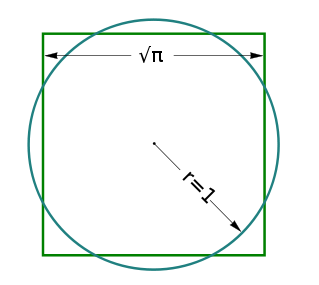Easier Than Pi

But that has not stopped others from trying. Of particular note is the attempt of an amateur mathematician named Edwin J. Goodwin, who claimed to have discovered the mysterious solutions to problems long since believed impossible — because they were, in fact, impossible. Beyond squaring the circle, he also claimed to have solutions for angle trisection and doubling the cube, a trifecta which, if accomplished, would put his name alongside that of Euclid himself. Both of those are also unsolvable, though, so Goodwin wasn’t often taken seriously.
He was more than just a mere crank. In 1897, Goodwin convinced the legislature of Indiana to draft and nearly pass a bill which would establish his “solutions” as scientific “fact.” While the bill never explicitly mentions pi — the goal of the bill was to “square the circle” as explained above — the text of the bill stated that “the ratio of the diameter and circumference is as five-fourths to four.” As pi is the ratio of the diameter and circumference, Goodwin’s law implies that pi is equal to 4/1.25, or 3.2. As a result, this proposed legislation became known as the “Indiana Pi Bill.”
The bill passed Indiana’s House of Representatives. But, by stroke of luck, Purdue University math professor C.A. Waldo arrived in Indianapolis on separate business at the same time. A legislator showed the bill to Waldo and offered to introduce him to the mathematical genius behind it — and instead, Waldo convinced enough members of the other house of the Indiana Congress to delay the vote on the Pi Bill. It died in committee in the Senate, thankfully for anyone other than the world’s humorists.
Pi is still 3.141592 (etc.) in Indiana. And, for that matter, everywhere.
Bonus fact: Want to learn pi to its 20th decimal? Memorize the following rhyme; the number of letters in each word (ignoring punctuation) is equal to each digit, in order, starting with the 3 before the decimal point: Pie. I wish I could calculate pi. “Eureka!” cried the great inventor: “‘Christmas pudding, Christmas pie,’ is the problem’s very center!”
From the Archives: Tanks for the Info: How math helped the Allies in World War II.
Take the Quiz: Can you name the words or names that begin with the letters ‘pi’?

Leave a comment